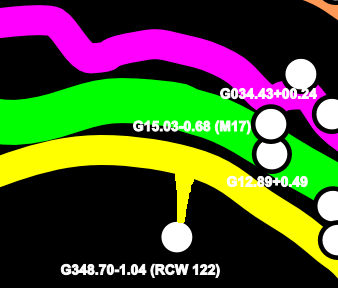The star formation region G348.70-1.04, associated with the HII region RCW 122 and the massive star cluster Havlen-Moffat 1, has a radio parallax based distance measurement of 3380 (-270 / +330) parsecs.
G348.70-1.04 is currently the only star formation region in the fourth quadrant with a published parallax-based distance measurement. It is located within about 11° of the galactic centre direction and thus the velocity data is subject to considerable compression.
G348.70-1.04 is not associated with a structure in the model used on this site. Although it is possible that this object has formed within an isolated hydrogen cloud in the inner galaxy, it seems more likely that such a massive star formation region is part of the Milky Way's major structure.
In this section I describe variations of my model that might incorporate RCW 122. The most likely option appears to be that RCW 122 lies within a peninsula that extends from the Norma arm towards the ring. However, I have deliberately not incorporated any of these variations into the model because they are all possible given the currently limited data. We will need more parallax data in the inner galaxy and in the fourth quadrant before we can determine how RCW 122 fits into a map of the Milky Way.
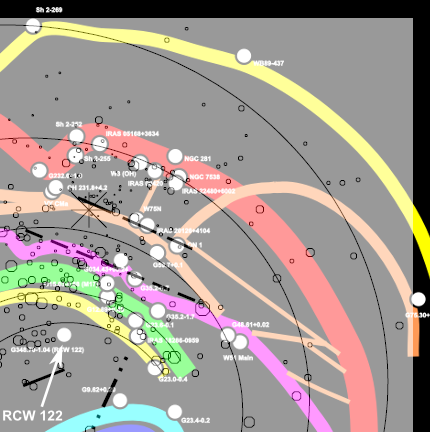
Diagram from Russeil, D.; Adami, C.; Georgelin, Y. M. 2007 laid on top of the model from this site. RCW 122 appears at the lower left. (Norma - yellow, Centaurus - green, Sagittarius - magenta, Perseus - red, spurs - orange, ring - cyan, bar - blue)
RCW 122 as part of the Norma arm
Delphine Russeil and colleagues have published two papers examining the velocity of HII regions and spiral structure. [Russeil, D. 2003, Russeil, D.; Adami, C.; Georgelin, Y. M. 2007] Although Russeil's model is largely restricted to four logarithmic spirals, it is broadly similar to the model used on this site (with a few exceptions) in regions of the galaxy where parallax measurements are available.
The parallax measurements suggest that the Russeil model underestimates the distance to the Sagittarius, Perseus and Norma arms in most of the first and second quadrants, likely because these arms deviate from the exact logarithmic spiral shape. In the case of the Sagittarius arm, Russeil notes this in her 2003 paper and adds a dashed line to her diagram showing the actual position (lower dashed line in image to the right) which agrees well with the parallax data and the model used on this site.
The Russeil model gives a sharper bend to the Norma and Centaurus arms as they enter the fourth quadrant compared to the model used on this site and is therefore able to place RCW 122 in or near the Norma arm.
RCW 122 as part of the Centaurus arm
The paper announcing the parallax measurements for RCW 122 [Wu, Y. W. et.al. 2012] states that this result indicates that RCW 122 "is in the Scutum-Centaurus arm".
This conclusion is inconsistent with both the model used on this site and the Russeil model. It would be possible if both the Norma and Centaurus arms bend even more sharply than the Russeil model as they enter the fourth quadrant. Such a large bend, if continued further into the fourth quadrant, appears to be inconsistent with the available velocity data but cannot be ruled out entirely without more fourth quadrant parallax data.
RCW 122 as part of the ring or a spur/peninsula
As mentioned in the section on the Ring and bar, the ring is a complex structure that appears to have two distinct rings and at least two internal spurs. It is possible (although unlikely) that a structure from the ring extends as far as RCW 122.
It is also possible that RCW 122 is located on a spur or a peninsula between the ring and the Norma arm. Indeed there is evidence for a peninsula in the LAB data. This can be seen if we look at the antimodel for the velocity data I have associated with the Sagittarius arm.
In the image below, I have overlaid a portion of the Sagittarius antimodel on top of a view show the objects with parallax measurements:
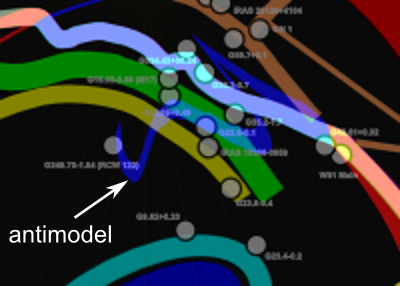
The tip of the antimodel intersects RCW 122.
This suggests that the Sagittarius arm originates at 350° and that the emission at 349° belongs to another structure related to RCW 122.
A look at the velocity data I have associated with the Sagittarius arm supports this conclusion. The emission at 359° may not be related to the Sagittarius arm:
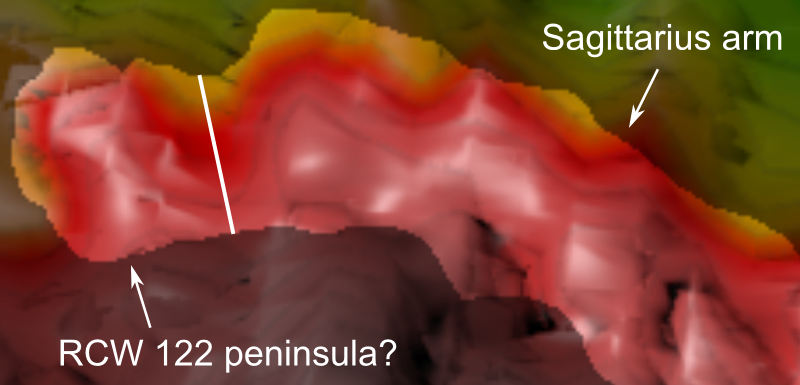
A close look at the 349° structure shows one or more filaments that terminate in an oval. RCW 122 appears to be located in the direction of the edge of this oval. (Note however that the oval has a velocity of about -23 km/s and RCW 122 is usually considered to have a less negative velocity of -12 to -13 km/s [Arnal, E. M. et.al. 2008] so in fact RCW 122 may not be associated with this oval. This discrepancy could be explained if there were a 10 km/s difference between the star formation region velocity and the surrounding gas, as has already been observed for the Perseus arm in the second quadrant.)
But can this structure really be connected to the Norma arm instead? With the help of the Velocity Explorer, we can find evidence that it is. The next image is a cross fade between the 80 K LAB isosurface and the highlighted Norma velocity data. I have circled the structure that appears to form the peninsula extending from the Norma arm:
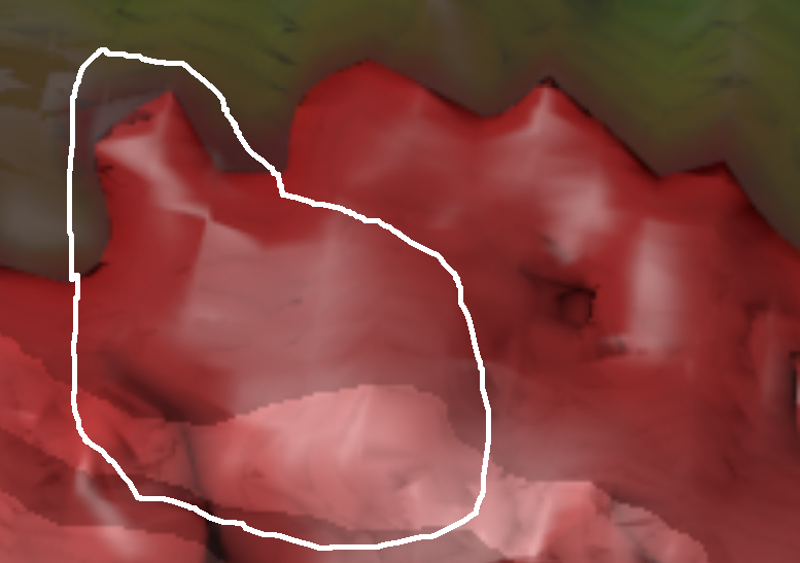
Very roughly, the RCW 122 peninsula might look like this:
